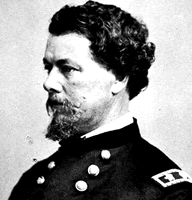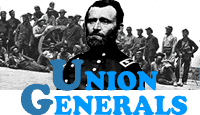
|
|
VITAL STATISTICS
|
BORN: 1820 in Clinton, CT.
DIED: 1899 in Washington, DC.
CAMPAIGNS: First Bull Run, Port Royal, Seccessionville, Gettysburg,
Rappahannock Station, Mine Run, Wilderness, Cold Harbor, Petersburg,
Shenandoah Valley (1864), and Cedar Creek.
HIGHEST RANK ACHIEVED: Major General.
|
|
BIOGRAPHY
|
| Horatio Gouverneur Wright was born on March 6, 1820, in Clinton, Connecticut. After graduating from West Point in 1841, he was assigned to the Corps of Engineers. There he helped construct the fortifications and harbors, while teaching French and engineering at the Military Academy. In 1855, he was appointed a captain. In April of 1861, he served as chief engineer of the federal attempt to destroy the Norfolk Navy Yard before it was captured by the Confederates. Wright was captured in the attempt, but was soon released. At the first Battle of Bull Run, he served as chief engineer of Brig. Gen. Samuel P. Heintzelman's division. By September 16, 1861, Wright was promoted to the rank of brigadier general. He then commanded a brigade in the operation against Port Royal, South Carolina. In 1862, he was placed in command of a division, which was defeated at Secessionville, South Carolina. After this, the War Department assigned Wright to command the Department of the Ohio, headquartered in Cincinnati, Ohio. Although he was promoted to major general, the Senate revoked his appointment. Wright maintained his command of the Department of the Ohio until 1863, when he took command of a division in Maj. Gen. John Sedgwick's VI Corps. Leading his command at Gettysburg, Rappahannock Station, Mine Run and the Wilderness, Wright became corps commander when Sedgwick was killed. Promoted to major general to rank from May 12, 1864, Wright directed the VI Corps at Cold Harbor and in the early part of the Petersburg Campaign. Under Wright's leadership, the corps fought against Lt. Gen. Jubal A. Early's Confederate troops in the Shenandoah Valley. Wright cautiously pursued the Confederates after they abandoned their raid against Washington, D.C. Later, the corps joined Maj. Gen. Philip H. Sheridan's forces in opposing Early's troops. At one point, when Sheridan was absent, Early surprised the Union troops, under Wright's command. The Union troops regrouped and were led to victory when Sheridan returned. Wright and his corps then returned to Petersburg, remaining active in the war effort until the end of the war. After the war, Wright was placed in the regular rank of lieutenant colonel, and commanded the Department of Texas for a year. He returned to engineering, and was commissioned brigadier general and named chief engineer in 1879. One of the projects he directed was the completion of the Washington Monument. In 1884, on his 64th birthday, Wright retired, and spent his retirement years in Washington, D.C. He died there, on July 2, 1899. |
|

